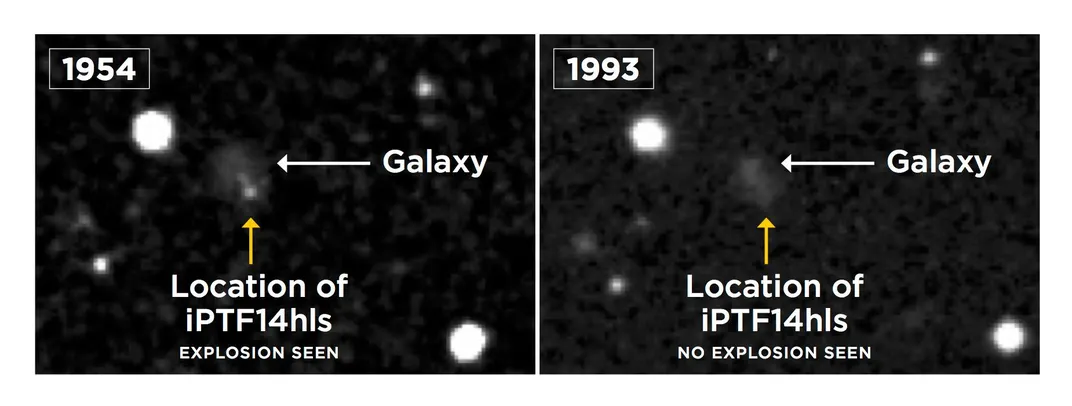“Zombie Star” Has Astronomers Stumped
The supernova that came back from the dead.
/https://tf-cmsv2-smithsonianmag-media.s3.amazonaws.com/filer/a5/69/a56973e7-c37e-4e26-be68-cdb282e2e3f8/1987a_hubble.jpg)
A supernova discovered three years ago has turned out to be far more interesting than it first appeared to be—and perhaps evidence of some previously undetected type of astronomical event. The object, designated iPTF14hls, remained bright for months longer than a typical supernova, leading a team of astronomers to say it could be powered by a type of explosion that had been theorized but never seen.
“Nobody expected a supernova with the properties we’ve seen, so in that sense it has come as a complete surprise,” says Andy Howell, a member of the study team and leader of the supernova group at Las Cumbres Observatory (LCO) in California. “We’ve shown it to hundreds of supernova specialists, and all are stumped.” The team reported its findings in the November 8 issue of Nature.
The supernova was discovered in September 2014 on the outskirts of a galaxy about 500 million light-years away, by the Intermediate Palomar Transient Factory, an automated search telescope run by an international consortium.
The object initially resembled a Type II-P supernova, which is the most common variety. Such a supernova forms when a massive star can no longer sustain nuclear reactions in its core, which then collapses to form a neutron star or black hole. The star’s outer layers fall inward then rebound, blasting into space in an explosion that can shine 100 million times brighter than the Sun.
This kind of supernova typically fades in about 100 days. But follow-up observations in February 2015 showed that iPTF14hls was still shining brightly. So astronomers began extensive observations with telescopes on the ground and in space. “We’ve never monitored a supernova as closely as this one,” says Howell. The observations showed that the supernova remained bright for 600 days, which had never been seen in a Type II-P event.
In addition, its brightness peaked five times, not once, as is typical for supernovas. The inner layers of ejected gas moved as fast as the outermost layers, which also sets it apart from other stellar explosions. And while a typical supernova gets cooler as it evolves, this one stayed about the same temperature. “The object’s spectrum is a textbook Type IIP supernova spectrum, while everything else about it is very strange,” says Iair Arcavi, another LCO astronomer and lead author on the Nature paper.
To make the case even stranger, the star appears to have undergone a similar outburst 60 years earlier, leading some scientists to call it a “zombie star.” Archival images show a supernova-like explosion at the same location in 1954, and “there’s a 95 to 99 percent chance that it’s the same star,” Arcavi says.

The model that best fits the observations, according to Arcavi and his colleagues, is known as a pulsational pair-instability supernova, in which the interior of a star at least 100 times the mass of the Sun gets so hot that it produces pairs of electrons and their antimatter equivalents, positrons. They provide the energy to power the supernova. Such a mechanism has been theorized for about a decade, but no pulsational pair-instability supernova candidate had yet been seen.
The model says that an initial blast should expel the star’s outermost layers, which are rich in hydrogen—enough material to make several dozen stars as big as the Sun. “But if the star is heavy enough, it doesn’t blow apart the whole star,” says Howell. “The remnants of the star can settle back down and keep on living. Then the star’s core gets hot enough to do it again. It can keep doing this several times, before finally blowing up as a normal supernova.”
Indeed, an archival search suggests that at least one more big outburst preceded the 2014 explosion. The 2014 explosion probably was the final blast, Arcavi says, with the star’s core collapsing to form a black hole roughly 40 times the mass of the Sun.
The pulsational pair-instability model has problems, though. “The models predict that most of the hydrogen of the star should be removed with the first explosion, but we see a lot of hydrogen in the 2014 explosion,” says Arcavi. “Second, the energy we estimate for the 2014 explosion is more than what the theory predicts for all explosions put together. So if it is the first pulsational pair-instability supernova, we need to figure out why it doesn’t look exactly as expected.”
“It’s very rare and exotic,” says Adam Burrows, an astrophysicist and supernova expert at Princeton who was not affiliated with the study. “It’s not a garden-variety supernova. But no model [exactly] fits its light curve. What’s powering it is an open question.”